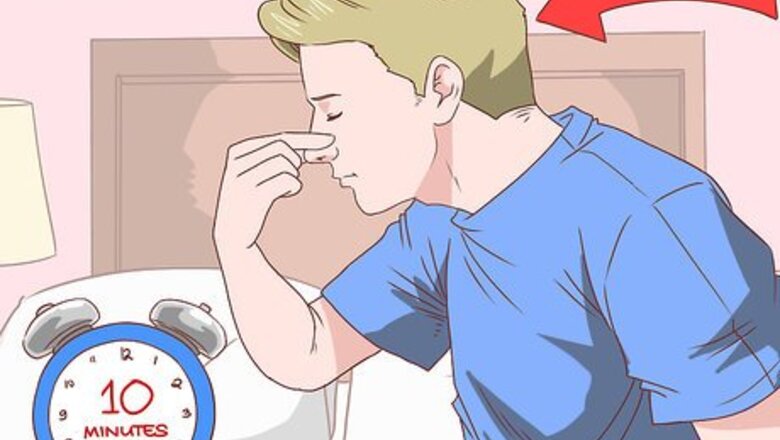
views
- To heal a cut in your nose, apply gentle pressure to it to stop the bleeding and carefully clean the area with soap and water.
- Apply antibacterial cream or ointment to your cut and avoid touching it (except to clean it daily) while it scabs over and heals.
- See a doctor if the wound is hard to reach, the bleeding won't stop after 20 minutes, the wound won't close, or you develop an infection.
Cleaning the Injury
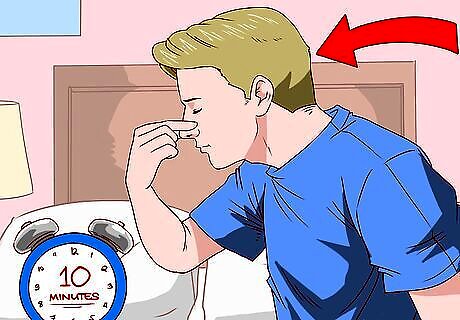
Apply gentle pressure to the cut to stop the bleeding. If the cut or sore is bleeding and is very near the edge of the nose, wash your hands thoroughly, then gently apply pressure to the wound with a clean cloth, paper towel, or bandage until the bleeding stops. Do not block your breathing and do not pack the nostril. If the injury is not clearly visible or is not right on the edge of your nose, then use the following first aid methods to stop the bleeding: Sit up straight and lean forward. Maintaining this position helps to reduce the pressure in the blood vessels in your nose and prevents you from swallowing any blood. Pinch your nose shut with your thumb and index finger and hold it shut for about 10 minutes. Breathe through your mouth during this time. After 10 minutes, release the hold. If your nose is still bleeding, then repeat the procedure. If it still bleeds after 20 minutes, seek medical advice, since this might be a sign of a more serious injury. Stay cool during this process by wiping your face with a cold cloth or sucking on something cold, like ice chips.
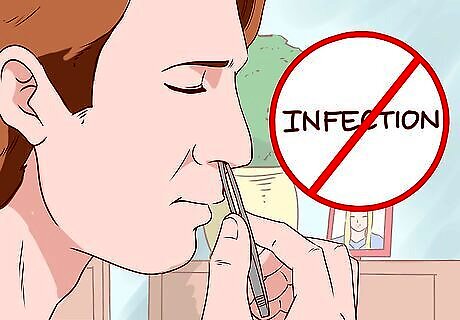
Use sterilized tweezers to remove any debris from the cut. If you think something is lodged in the area, or if you just need to clean out any skin fragments, tissue, or blood clots, use tweezers or another tool to pluck the debris or other materials from your nose. Sterilize the items you plan to use. Take care not to aggravate the injury or cut yourself with the tweezers. To sterilize your tools: Wash your hands and your utensil, like tweezers, thoroughly with soap and hot water, then rinse them completely. Place the items in a pot or pan with enough water to cover them. Put on the lid and bring the water to a boil for 15 minutes with the lid in place. Remove the pan from the heat, keeping the lid in place, and let it cool to room temperature. Drain the pan without touching the sterilized items. If you are not ready to use them, leave them in the drained pot or pan with the lid on. Carefully remove the items when you are ready to use them. Avoid touching the parts of the tools that will come into contact with the injury. Touch only the handles or grips.

Clean the tissue around the cut with soap and water. In order to reach the cut to clean it, you may need to use a cotton swab or a piece of rolled up gauze. Use fresh water and mild soap on the end of the cotton swab or gauze and dab the cut gently. Repeat with clean, fresh water and a new swab to rinse away any soap residue. Use clean or sterilized tweezers to hold the gauze in order to effectively clean the area.
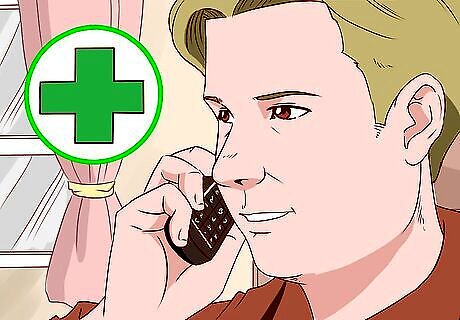
Seek medical help if the area is too hard to reach. If you cannot easily see or reach the cut, then you may have trouble properly treating the area. You could do additional damage or introduce bacteria if the cut is high up inside the nose. Call your doctor or go to an urgent care clinic instead of trying to deal with the cut yourself.
Treating the Cut with Antibacterial Ointment
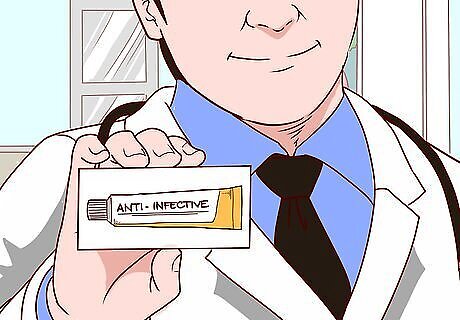
Apply antibacterial cream or ointment to your cut. Ask your doctor what they recommend to apply to your cut—they’ll likely recommend a product that can be purchased without a prescription at your local pharmacy. Place a small amount of the antibacterial cream or ointment on the end of a cotton swab or on a small piece of gauze. Carefully apply the medicated cream or ointment to the area surrounding the cut. Consult with your doctor about appropriate antibacterial creams and ointments to use before applying anything to your cut. Certain creams and ointments may not be appropriate for more severe injuries further up inside your nose. Try to avoid touching the cut with your fingers. If you must use your hands to apply treatment, then be sure to wash them thoroughly with hot, soapy water first.
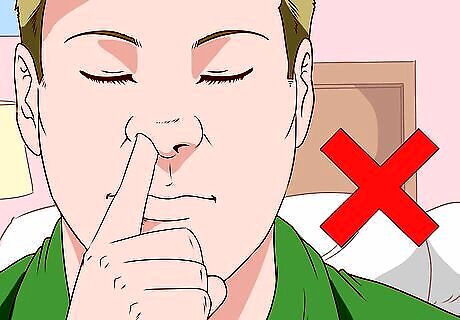
Avoid picking at the wound while it heals. Once you have applied the medication, leave the area alone. Keep your fingers away and do not pick at the wound if it scabs. Picking at the area can prevent the cut from healing and increase your risk of infection. Clean the area daily and apply petroleum jelly, Vaseline, or a moisturizer that's safe for your nose to help prevent the formation of large and uncomfortable scabs. Wounds with scabs take longer to heal, and keeping the wound moist may prevent it from scabbing over. If scabs do form, avoid picking at them. Scabs will typically heal and fall off within 3-7 days, depending on the size and severity of the wound.
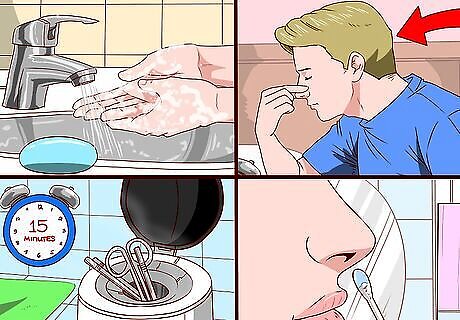
Re-apply the treatment daily or every couple of days. Depending on the placement of the cut, its length, and its depth, you may need to repeat the application of the medication every day, or every few days. Use caution so as not to disrupt the wound and introduce any bacteria.
Seeking Medical Attention for Severe Cases
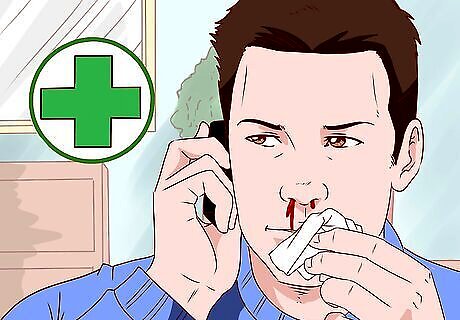
Seek medical attention if the bleeding does not stop after 20 minutes. Persistent bleeding can indicate a broken bone, a deep cut inside your nose, or a more severe medical condition. Bleeding that continues for more than 15 to 20 minutes is a warning sign that something more serious may have happened.

See your doctor if the cut does not begin to heal within a few days. Some injuries that occur inside the nostrils may need to be medically treated. The nose is a sensitive area with a lot of blood vessels, fluids (like mucus), and sinus drainage, all of which contain bacteria. Some injuries that occur inside the nose need to be treated by a doctor, or even a specialist, such as an ear, nose, and throat (ENT) doctor. In some cases, the wound may seem to heal properly, but returns in a few weeks or months. This is a sign of a possible infection. Ask your doctor about antibiotics and medical procedures that can prevent your sore from coming back.

Seek medical help if an animal or dirty object caused the injury. If your cut was caused by an animal or by something dirty with ragged and uneven edges, you need to be certain that the area is properly cleaned and treated. The earlier you identify an infection, the easier it will be to safely treat and control. See a doctor as soon as possible if your nasal injury was caused by something that could carry the potential for a serious systemic infection.
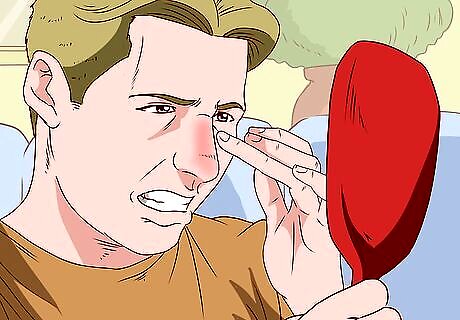
Watch for signs of infection like swelling, drainage, or fever. Regardless of the cause of the cut, infections warrant prompt medical attention. Heed the following symptoms of infection and see your doctor as soon as possible: The area does not improve in a few days or begins to get worse. The area begins to swell and feels warm to the touch. The wound is causing a thick or pus-like drainage and you notice an odor coming from the injury or the drainage. You start to run a fever.
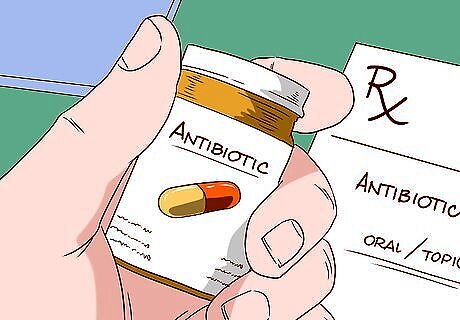
Ask your doctor about treatments for an infection. In most cases, a physician will write you a prescription for an oral or topical antibiotic. Depending on the treatment, you can expect the cut to heal within a week or two once you have begun an antibiotic regimen.

Talk to your doctor if you have unexplained sores or scabs in your nose. If you have sores, scabs, or wounds in your nose and you’re not sure what’s causing them, make an appointment with your doctor. In the meantime, continue applying an antibacterial cream to the scab to prevent infection and use petroleum jelly or a moisturizing nasal saline spray to keep your nose from drying out further. Nasal sores or nosebleeds can be a symptom of an underlying condition, such as: A sinus infection or cold Allergies A bleeding disorder or excess bleeding caused by certain medications A deviated septum A more serious infection in the nose, such as MRSA (a type of antibiotic-resistant bacterial infection) In rare cases, sores in the nose can be a symptom of a serious medical condition such as nasal cancer, lupus, or HIV/AIDS.















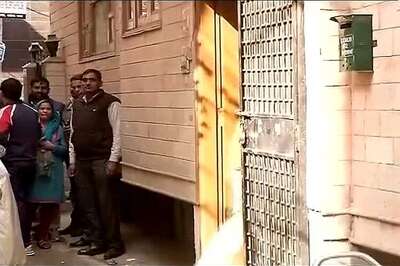




Comments
0 comment